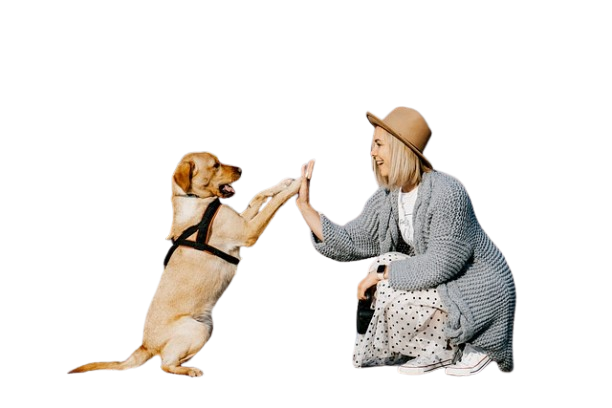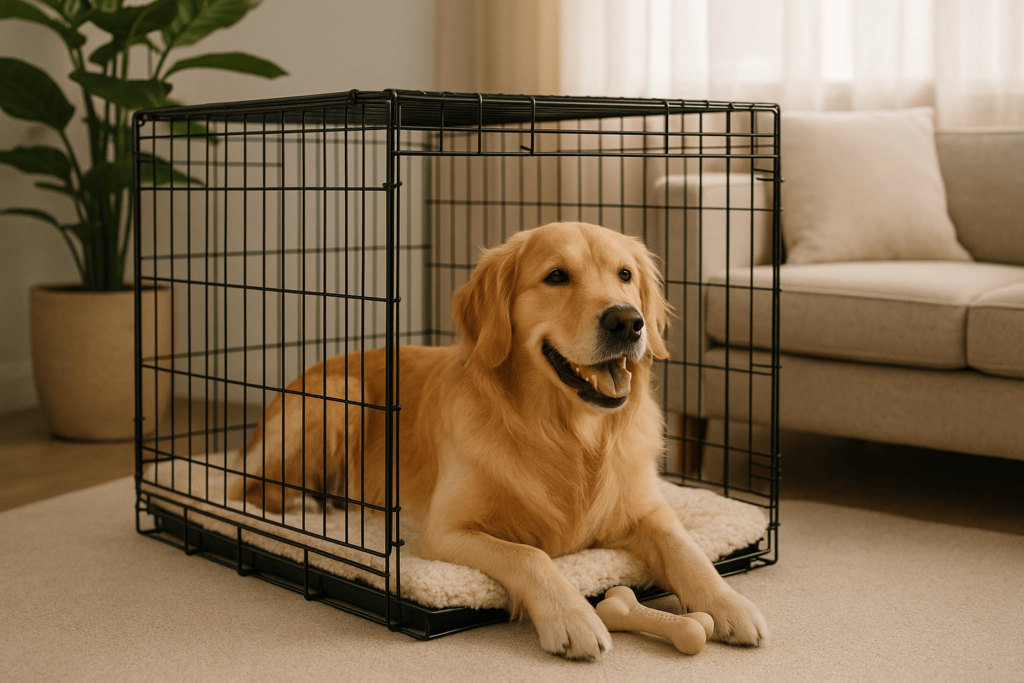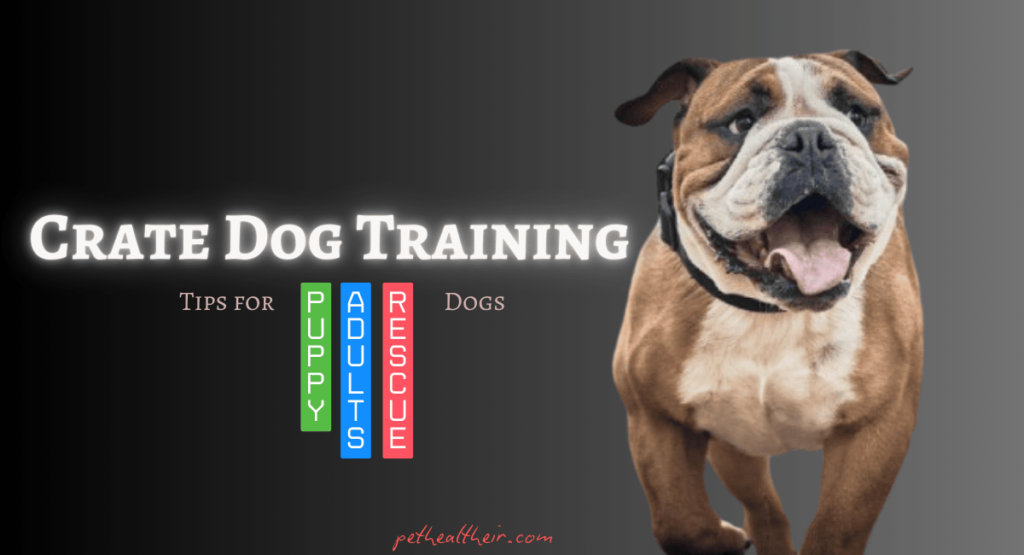Dog Crate training is an essential tool for creating a safe and secure environment for your furry friend. By giving your dog their own personal space, you can help reduce anxiety, simplify housebreaking, and establish boundaries in your home. Crate training is not just for puppies; it’s a valuable technique for adult dogs, older dogs, and even rescues. With patience and the right approach, crate dog training can lead to a happier, more well-adjusted pet.
Benefits of Crate Training: Safety, Comfort, and Security
Crate training offers a variety of benefits that can improve both your dog’s well-being and your peace of mind. Here’s how it helps:
- Safety:
A crate provides a secure space where your dog can stay out of harm’s way when unsupervised. It prevents accidents, such as chewing on dangerous items or getting into off-limits areas, especially for curious puppies or dogs adjusting to a new home. - Comfort:
Dogs naturally seek out cozy, den-like spaces where they can relax and unwind. A properly sized crate becomes their personal sanctuary, offering comfort and a sense of belonging. It can also help reduce stress during travel or unfamiliar situations. - Security:
A crate helps dogs feel safe by mimicking the instinctual shelter of a den. This is particularly beneficial for anxious dogs or those adjusting to new environments. Crates also give dogs a predictable routine, which can alleviate uncertainty - and promote a calm demeanor.
Crate Training for Dogs of All Ages
Crate training is a versatile and valuable tool that benefits dogs at every stage of life. Whether you’re working with an energetic puppy, an adult dog, or even a senior, crate training can help establish structure and security. It’s especially useful for rescue dogs or those from shelters, providing them with a safe, comforting space as they adjust to their new environment. Regardless of age or background, any dog can learn to view their crate as a positive and peaceful retreat with the right training approach.
What is Dog Crate Training
Dog crate training is a process of teaching your dog to see a crate as a safe and comfortable space. It involves gradually introducing your dog to the crate and making it a positive environment where they feel secure. The goal is to create a space where the dog willingly goes to relax, rest, or stay when needed.
Benefits of Dog Crate Training:
- Safety and Security: Dogs are naturally den animals, and crates can provide a sense of security.
- House Training Aid: Crates help with potty training by teaching dogs to control their bladder since they avoid soiling their resting area.
- Prevents Destructive Behavior: A crate can keep your dog out of trouble when you’re not around to supervise.
- Travel Convenience: Crate-trained dogs adapt better to traveling and are safer during car rides or flights.
- Stress Reduction: During events like fireworks or visits to the vet, a familiar crate can help calm your dog.
Crate Training Adult Dogs
Crate training an adult dog can be a rewarding and effective way to create a safe, comfortable space for your furry friend while addressing behavioral or practical needs. Here’s a step-by-step guide tailored for adult dogs:

Steps to Crate Train an Adult Dog
1. Choose the Right Crate
- Size: Your dog should be able to stand, turn, and lie comfortably but not so large they can designate a potty corner.
- Type: Opt for a sturdy plastic or metal crate with good ventilation.
2. Make It Inviting
- Line the crate with a soft blanket or crate pad.
- Add a favorite toy or treat to encourage exploration.
- Place the crate in a quiet, family-oriented area of your home.
3. Introduce the Crate Gradually
- Start by leaving the door open and letting your dog explore it on their own.
- Use treats or kibble to lure them inside, praising them for every step they take.
- Avoid forcing them inside as it can create negative associations.
4. Create Positive Associations
- Feed your dog meals inside the crate to build a connection between the crate and good experiences.
- Reward calm behavior with treats or gentle praise.
5. Close the Door Briefly
- Once your dog is comfortable entering the crate, gently close the door for a few seconds while they’re inside.
- Gradually increase the time, staying close initially to reassure them.
6. Establish a Routine
- Use the crate during specific times, such as bedtime or when you’re briefly leaving the house.
- Keep the schedule consistent to help your dog understand when and why the crate is used.
7. Address Whining or Barking
- Ignore whining unless you’re certain it’s for potty needs.
- Reward calmness, not noise, to avoid reinforcing the wrong behavior.
Crate Training Dogs at Night
Crate dog training at night helps your pup feel secure while building good habits. Here’s how to make it easy:

- Pick the Right Crate: Choose a crate big enough for your dog to stand and turn but small enough to discourage bathroom use.
- Make It Cozy: Add a soft blanket, their favorite toy, and place it in a quiet spot.
- Build Positive Associations: Use treats and praise to encourage your dog to enter the crate willingly.
- Set a Routine: Take your dog out for a potty break before bedtime and stick to a regular schedule.
- Handle Whining Wisely: Ignore attention-seeking noise, but ensure young puppies get necessary potty breaks.
- Create Comfort: Keep the crate in your bedroom initially to reduce anxiety and provide a calm sleeping space.
Consistency is key for successful crate dog training. A well-trained dog will see the crate as their safe haven and sleep soundly through the night!
Crate Training an Older Dog
Crate training an older dog is possible with patience and care. Follow these steps:
- Choose the Right Crate: Ensure it’s spacious and comfortable with soft bedding.
- Introduce Slowly: Keep the door open and encourage your dog with treats and toys.
- Make It Positive: Feed meals inside the crate and reward your dog for entering.
- Start Small: Begin with short sessions, gradually increasing the time.
- Stick to a Routine: Use the crate for sleeping and quiet time, with potty breaks before crating.
- Calm Anxiety: Keep the crate in a quiet area and provide reassurance if needed.
How to Crate Train a Rescue Dog
Crate dog training a rescue dog helps them feel safe and secure while building trust in their new environment. Start by selecting a crate that is spacious enough for them to relax and line it with soft bedding for added comfort. Allow your dog to explore the crate at their own pace, using treats and toys to create a positive experience. Feeding meals inside the crate can further build trust and help them associate the space with comfort.
Begin with short crate sessions and gradually increase the duration as they become more comfortable. Consistency is key—stick to a routine and ensure potty breaks before crating. With patience and gentle encouragement, your rescue dog will see the crate as their personal sanctuary.
How to Crate Train a Dog from a Shelter
Crate dog training for a shelter dog helps them feel secure and adjust to their new home. Begin by selecting a crate that fits your dog comfortably, allowing them to stand, turn, and lie down. Make the crate cozy with soft bedding or a blanket and add a toy to make it inviting.
Introduce the crate gradually, leaving the door open and using treats or gentle encouragement to help them explore. Feeding meals inside the crate is an excellent way to create positive associations. Avoid forcing them in or using the crate as a form of punishment.
Start with short sessions and slowly increase the time as they grow more comfortable. Stick to a routine, using the crate for naps and quiet time, and always provide a potty break before crating. With patience and consistency, crate dog training can transform the crate into a safe and comforting space for your shelter dog. 🐾


